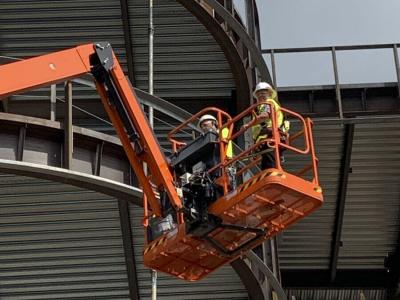Some contractors and developers say they are locking in skilled tradespeople like carpenters and electricians months before they usually would, promising overtime to make the jobs more enticing, and advising clients to speed up or postpone projects to avoid the labor crunch.
The Chicago Tribune is reporting that cranes have sprouted in Chicago as surely as tulips, but a busy construction season is coming with concerns that there aren't enough skilled workers to do all the building.
The construction workforce, which thinned out dramatically as work dried up during the economic downturn, is only three-quarters what it was pre-recession. Project demand, meanwhile, is booming.
"We're out of balance," said Tom Fioretti, east region lead for project and development services at Cushman & Wakefield, where he represents commercial and office tenants.
To cope, some contractors and developers say they are locking in skilled tradespeople like carpenters and electricians months before they usually would, promising overtime to make the jobs more enticing, and advising clients to speed up or postpone projects to avoid the labor crunch.
So far it has been manageable, they say, but they worry it will get worse as the year goes on.
"Until the demand comes down or we get more labor, we will see higher prices and longer construction schedules," Fioretti said.
Labor shortages and gluts are part of the industry's regular cycles, but "we're seeing an extreme cycle right now" as pent-up project demand meets a labor force that lost a lot of workers who retired or switched to other industries during the recession, said Chris Redpath, a partner in the Chicago office of Clune Construction.
The construction workforce in the Chicago metro area plunged from 29,600 people in 2008 to 18,100 in 2011, and while it has been slowly building back up, fewer than 22,000 people were working in the industry last year, or about 74 percent of the pre-recession level, according to data compiled by Cushman.
Meanwhile, construction activity is back in full swing and several major projects are gobbling a lot of workers. The number of construction permits issued for improvements at office buildings in the central business district, which took a steep dive from 828 in 2008 to 538 in 2009, has inched back up to pre-recession levels, hitting 897 in 2014 and 806 last year, according to Cushman's data. The total declared value of the permits is higher than it was before the downturn, $459 million last year versus $427 million in 2008, adjusted for inflation, suggesting higher construction costs.
Various office trends are driving up construction demand, including companies migrating downtown from the suburbs, expanding as they recover from the recession or transforming their spaces to more open floor plans, Fioretti said.
Open floor plans tend to decrease a company's overall footprint, which puts more space on the market and makes it more appealing for other companies wishing to move.
But lingering hangovers from the recession mean there aren't enough new workers to fill all the construction jobs, some contractors say.
When work was scarce, some workers retired early and others switched careers, compounding concerns about an aging construction workforce. The median age of construction workers climbed to 40.4 in 2010 from 37.9 in 2000, according to The Center for Construction Research and Training.
In addition, unions put apprenticeship programs on hold. They have come back online as projects have picked up, but the programs are several years long so there is a lag in turning out the needed skilled labor, Redpath said.
Some subcontractors that downsized during the recession and learned to work with fewer people also have been reluctant to expand again, so they have limited capacity and are being choosy about the projects they take on, Fioretti said.
"That is causing tension and anxiety on our side with regard to pricing right now," said Greg Werner, vice president and general manager in the Chicago office of Mortenson, a construction and development company.
Werner's firm is projecting construction costs to rise about 4 percent this year, after rising 4.6 percent last year, the highest escalations since before the recession.
Some union reps say the concerns are overblown.
"I don't see a worker shortage," said Ralph Affrunti, president of the Chicago and Cook County Building and Construction Trades Council, which represents the area's building trade unions and their 100,000 members.
While 90 percent of the area's trades apprenticeships were put on hold during the recession, they all are running again, he said. People who left the industry to take different jobs are returning because they can get back to work full-time.
Unions can always pull manpower in from other cities and states, "so there will never be a shortage of construction workers in a major metro area," Affrunti said.
But Redpath said "travelers," as they are called, don't always do the best work.
Redpath, who estimates project costs have gone up 10 to 15 percent in the past six to eight months as demand heats up, said his firm has experienced lack of manpower on projects, which could potentially delay projects.
Not only are there penalties for being late, but there's also a domino effect if the job isn't finished on time and tenants can't move.
"Our whole industry is driven by schedule and budget," Redpath said. "If we can't deliver on time, it's a huge impact."
To avert that from happening, his company has been letting subcontractors know their labor needs months early so that they can reserve enough people.
Fioretti, who has worked with Redpath on several projects, said he has been advising clients to consider the timing of their projects.
For example, he said he recommended the law firm Seyfarth Shaw start the build-out on its new 190,000-square-foot office space in the Willis Tower ahead of the June 2017 expiration of its current lease to get ahead of growing market demand that could increase cost and schedule due to the limited skilled labor.
For other clients with leases expiring in a year or two, Fioretti said he has counseled that it may be better to sit tight and wait for demand to subside.
Daniel Cronin, vice president and regional operations manager in the Chicago office of Turner Construction, said he hired electricians for a large data center being built in a Cook County suburb four months earlier than he typically would.
To make the job more enticing, the company is guaranteeing 58-hour workweeks for the duration of the 18-month project, both to hit the schedule and attract workers with overtime, Cronin said.
Cronin, who is concerned about a shortage of sheet metal workers who do duct work for HVAC systems, said business is booming across all market segments, from health care and higher education to office and residential, and he thinks the labor shortage "is only going to get worse in the next 12 months."
At Mortensen, one strategy to manage the shortage is to expand the number of craft workers it directly employs so it does not have to rely on subcontractors, Werner said. Currently craft workers, who do things like concrete, drywall and ceiling work, comprise 110 out of the firm's 210 employees in Chicago, and the company expects to grow that by 20 to 25 percent, he said.
Mortenson makes it a point to reach into diverse talent pools to build its workforce, he added, and currently 11.4 percent of its craft workers are women, compared with 3.6 percent industrywide.
Jayne Vellinga, head of Chicago Women in Trades, said that while demand is up, she hasn't heard cries of a massive shortage. The nonprofit, which helps women pursue construction careers, has had "some really stunning success" with some of the unions lately, including a 300 percent increase in the number of female plumber apprentices, "but we also have unemployed tradeswomen."
Dan McLaughlin, executive director of the Builders Association, the area trade association for the commercial construction industry, said the workforce is starting to catch up after suffering a "triple whammy" during the recession, and unions are taking on larger apprenticeship classes to make up for the shortage.
"Once you start putting hundreds of apprentices back in the classroom, you'll catch up pretty quick," said McLaughlin, the longtime mayor of Orland Park. "Everyone has had to go into high gear."
Source: The Chicago Tribune
Today's top stories















